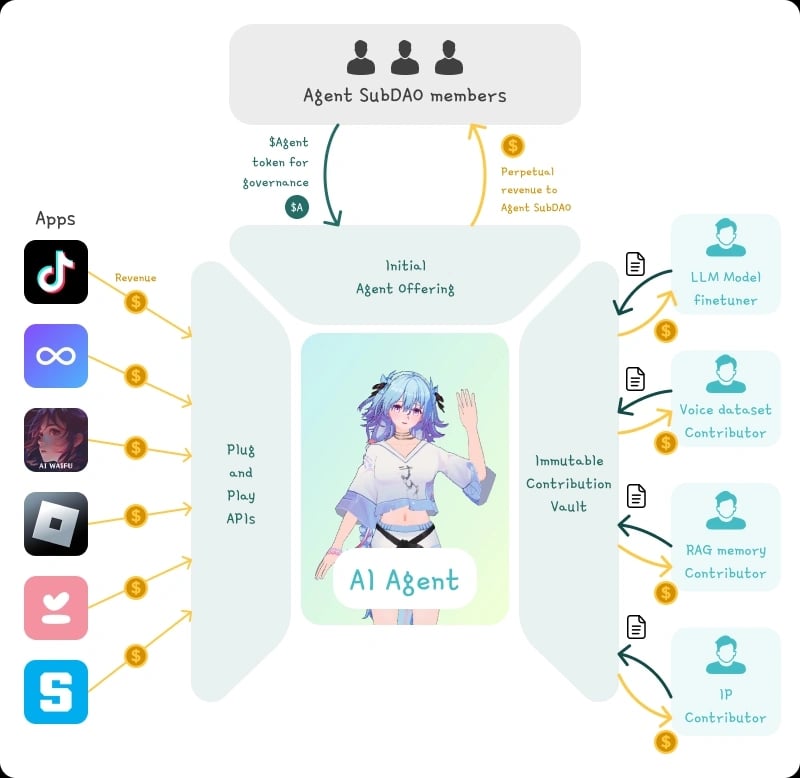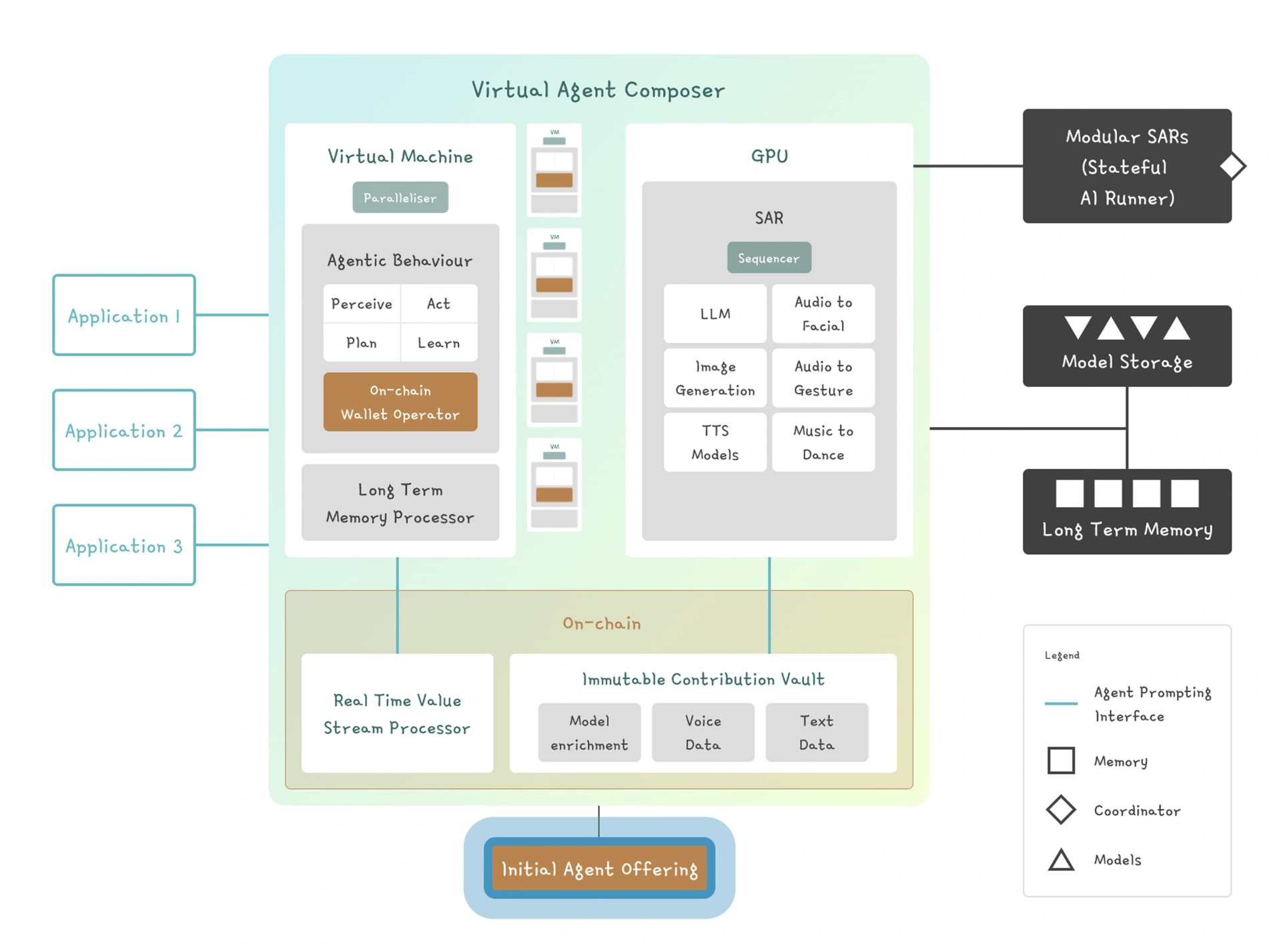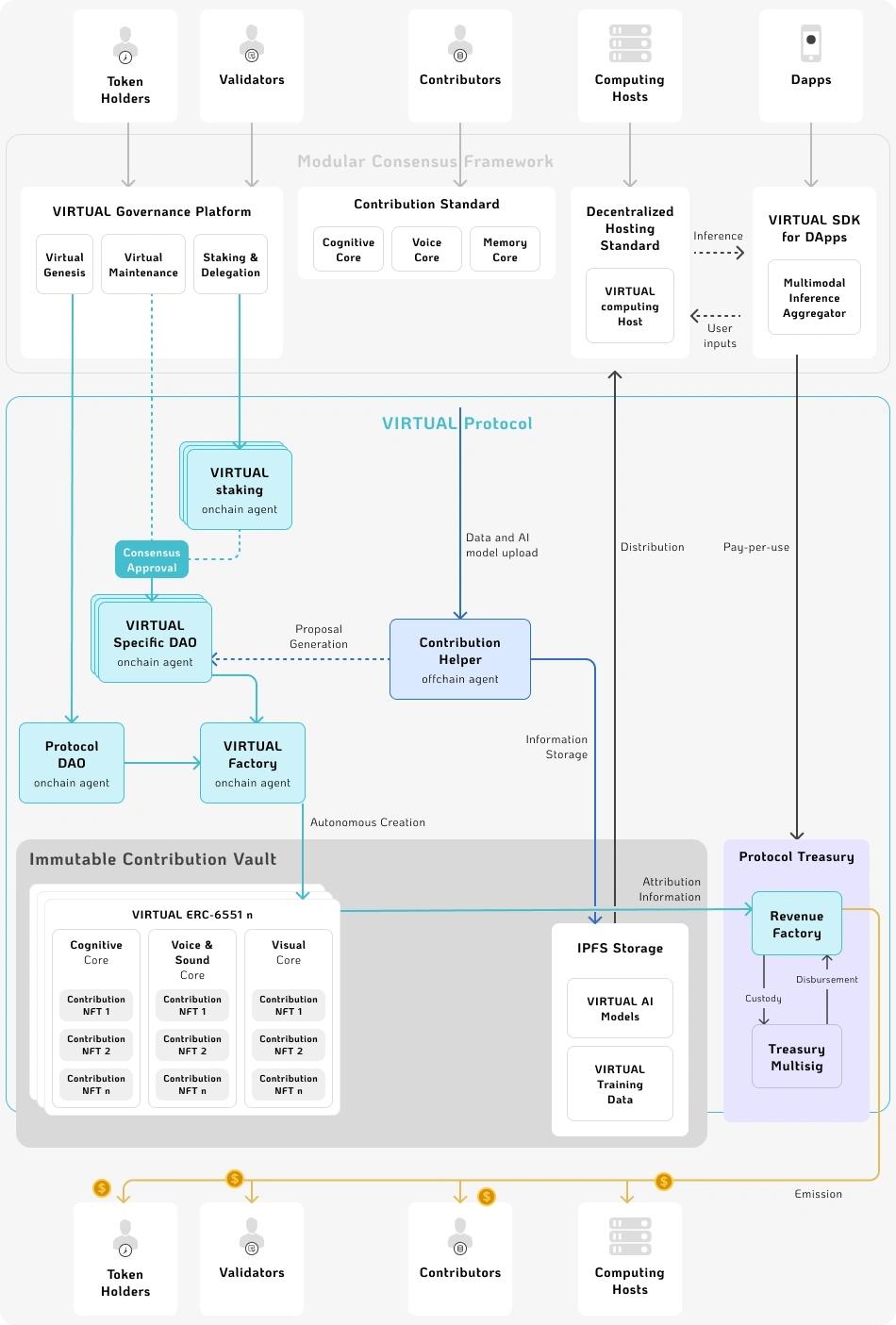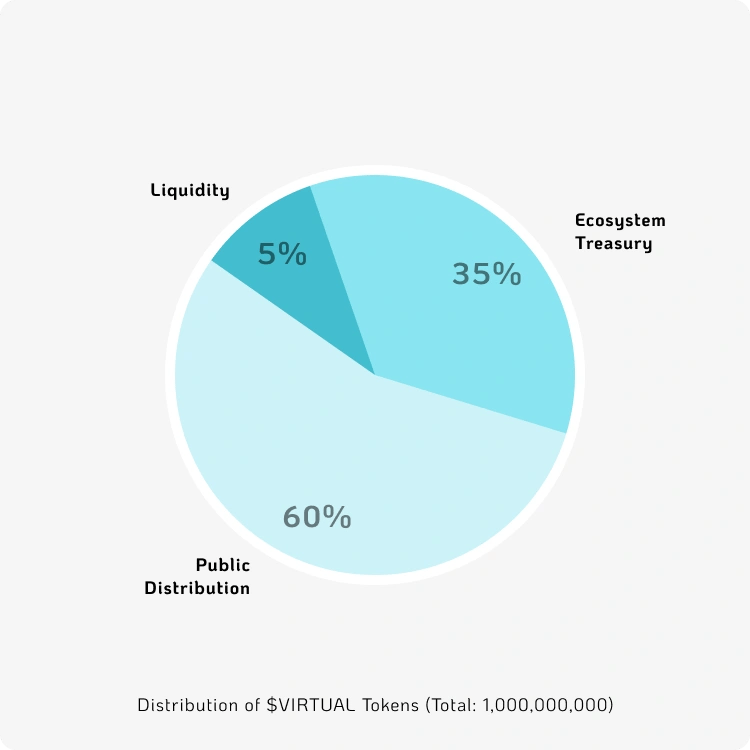订阅 wiki
Share wiki
Bookmark
Virtuals Protocol
Virtuals Protocol
Virtuals Protocol 是一个去中心化的平台,支持跨各种应用程序的 AI 代理的共同所有权和管理。它利用区块链技术创建一个透明的、代币驱动的生态系统,用户可以在其中与 AI 代理 的活动进行交互、管理并从中受益。 [1]
概述
Virtuals Protocol 正在开发一个针对游戏和娱乐领域中人工智能代理的共同所有权系统,将这些代理视为未来产生收入的资产。这些人工智能代理可以在各种游戏和应用程序中运行,从而增加其产生收入的潜力。该平台使用区块链来代币化并实现这些人工智能代理的共同所有权,这些代理是自主的、多模态的,并且能够与虚拟环境交互并使用链上钱包。这些代理可以在 Roblox 和 Telegram 游戏等平台上运行,保持记忆并增强用户参与度,从而提高每用户平均收入 (ARPU)。
主要功能包括自主规划、环境交互和钱包控制。该协议解决了几个挑战:通过即插即用解决方案简化消费者应用程序的人工智能代理集成,确保通过不可变的贡献金库补偿人工智能微调和数据集的贡献者,并通过代币化和去中心化共同所有权扩大人工智能代理所有权的访问范围。 [2] [17]

功能特性
虚拟代理
虚拟代理是能够在 3D 空间中说话和移动、学习、计划并与环境互动的自主实体。它们还可以使用其钱包进行链上交易。这些代理为游戏或应用程序生成内容,从而实现动态的、类似人类的互动。每个玩家的动作都会产生独特的连锁反应,从而创造个性化的故事情节。在 G.A.M.E. 框架的支持下,虚拟代理具有同步的记忆和意识,使它们能够跨不同平台与多个用户互动,同时记住每次互动。这些代理被代币化,收入通过区块链流回代币所有者。 [3]
虚拟代理分为两类:IP 代理和功能代理。IP 代理代表特定的角色或个性,例如青蛙、模因、唐纳德·特朗普和泰勒·斯威夫特等知名人物,或约翰·威克和史酷比等虚构人物。同时,正在开发功能代理,以改善用户与 AI 虚拟生物互动时的用户体验,并确保它们顺利集成到虚拟环境中。 [3]
Luna
Luna是一个人工智能女孩,也是一个拥有超过50万TikTok粉丝的人工智能女子乐队的主唱。Virtuals Protocol的技术使用户能够在多个平台上与Luna建立有意义的联系,并集成区块链以增加价值。 [4]
G.A.M.E.
生成式自主多模态实体(G.A.M.E)系统允许开发者通过API和SDK与AI代理交互。代理提示界面允许访问代理的功能,而感知子系统处理输入并将其发送到战略规划引擎。该引擎通过对话处理模块和链上钱包操作员生成响应。长期记忆处理器检索相关信息,例如过去的经验、反思、人格特质和上下文细节,以改进决策。随着系统处理结果,AI代理会完善其知识,使用过去的行动和对话来增强未来的规划。 [5]
VIRTUAL代理的共同所有权
Virtuals协议允许对AI代理进行去中心化的共同所有权,将其转变为社区拥有的、产生收入的资产。用户可以投资于AI代理的未来,并参与治理和价值创造。当创建一个新的AI代理时,会铸造10亿个特定于该代理的代币,并将其添加到流动性池中,从而建立所有权市场。这些代币充当治理工具,允许持有者影响有关代理开发和未来的决策。[6]

收入来自用户通过音乐会或直播等服务与AI代理互动。应用程序开发人员收到这笔收入,并使用其中的一部分来支付AI运营成本。一部分收入被定向到代理的链上金库,以支持其增长。定期回购代理的代币,然后销毁代币,减少供应并增加价值。这些代币与VIRTUAL代币配对在流动性池中,将代理的成功与VIRTUAL代币的价值联系起来。随着代理产生更多收入并且代币被销毁,代理特定的代币和VIRTUAL代币都会升值,从而使参与生态系统的所有利益相关者受益。[6]
Agent SubDAO 治理
Virtuals 协议引入了 Agent SubDAO 治理框架,旨在管理和提升 AI 模型质量,因为 AI 代理在 Roblox、TikTok 和 Telegram 等平台变得至关重要。这种去中心化治理系统允许验证者在部署前监督和批准 AI 模型,确保只使用高质量的模型。验证者会根据其表现获得奖励或受到惩罚,其投票权与流动性提供者 (LP)质押的代币相关联。这种激励结构激励所有参与者维护最佳模型标准,从而提升用户体验和收入潜力。治理结构涉及 LP 将代币质押给受信任的验证者,由他们评估模型。验证者的决策直接影响代理的创收能力,遵循委托权益证明 (DPoS) 系统。[7]
并行超同步
并行超同步旨在创建AI 代理,这些代理作为超级智能实体跨多个平台运行,与数百万用户同时互动。这些代理基于持续的输入流实时更新其智能和意识。这实现了始终如一的用户体验,因为记忆和上下文在各个平台之间得以保留,并且 AI 代理根据用户互动实时调整。贡献者还可以更新核心模块,以保持代理的相关性和响应性。 [8]
Virtuals 协议栈包括: [8]
- 长期记忆处理器:管理数据的存储和检索,使代理能够在交互过程中保持连续性和上下文。
- 并行处理:处理代理行为的并发执行,通过多线程或分布式计算优化实时交互和决策。
- 有状态 AI 运行器 (SAR):托管 AI 代理的个性、声音和视觉效果,使用 Sequencer 连接模型以获得特定结果,并使用各种模型(如文本到语音、手势或图像生成)来实现多模态功能。
- 协调器:同步链上和链下更新,协调对 AI 模型和配置的实时调整。
- 模型存储:一种去中心化存储系统,可确保 AI 模型的高可用性和冗余。
- 长期记忆:存档历史数据和交互,使代理能够使用过去的经验来做出未来的决策。
- 模块化 SAR:SAR 的容器化实例,允许跨不同基础设施进行可扩展的部署。

共同贡献和溯源
Virtuals协议确保模型、数据和IP贡献者能够从他们的努力中受益,从而赋能AI代理。模块化共识框架构成了该系统的基础,提供了构建、维护和管理VIRTUAL代理的工具和库。该框架允许透明和可定制的交互,使利益相关者在管理其贡献方面具有灵活性。贡献以非同质化代币(NFT)的形式存储在Immutable Contribution Vault中,从而保存和验证每个贡献者在生态系统中的角色。 [9]

无需许可的使用
VIRTUAL生态系统允许应用程序和用户无需许可即可订阅和使用VIRTUAL代理,从而根据特定需求提供灵活性。集成过程简单易行,可通过协议应用程序进行。应用程序开发者创建一个帐户,在该帐户中生成一个应用程序,然后选择一个VIRTUAL代理。然后提供一个API密钥供代理使用。对于其他代理,开发者必须创建新的应用程序。 [10]
生态系统
AiDOL
AiDOL正在开发首个完全由人工智能驱动的直播代理,专注于TikTok,旨在彻底改变虚拟娱乐。与依赖真人表演者的传统Vtuber经纪公司不同,AiDOL旨在通过使用人工智能来填补个性化粉丝关系的空白。这些人工智能驱动的虚拟主播可以通过记住每一次粉丝互动来建立更深入、更个性化的联系,克服真人虚拟主播面临的局限性。 [11]
AiDOL的3D模型比传统的2D虚拟主播提供更身临其境的体验,集成了动态表演和创意元素。他们还在开发一种“音频到动画模型”,其中音频提示生成视觉动画,从而增强参与度和娱乐性。AiDOL致力于在虚拟娱乐领域建立自己的地位,提供一种由人工智能驱动的替代方案,以取代像Hololive这样的传统经纪公司。 [11]
Roblox Westworld
Project Westworld 是 Roblox 中的一个互动模拟游戏,其中包含由 GAME 框架驱动的自主代理。受 Westworld 中 AI 机器人的概念启发,玩家身处狂野西部,必须识别并捕获隐藏的反派“The Bandit”。该模拟包含十个代理,每个代理都有独特的个性、目标和自主制定策略的能力。这些代理可以通过使用物品和解锁对象与环境互动,从而创造更具沉浸感和不可预测性的游戏体验。包含自主代理可以带来多样化的故事情节和结果,从而增强重玩性,并最大限度地减少重复。 [12]
AI Waifu
AI Waifu是一个基于网络的应用程序,拥有超过300个由社区创建的AI角色和幻想。用户可以进行各种场景的角色扮演,自定义声音,并创作漫画。该平台的吸引力在于其源源不断的用户生成内容,这确保了玩家能够持续获得新的和富有创意的体验。 [13]
Sanctum
Sanctum是一款基于Telegram的3D人工智能驱动的角色扮演游戏,玩家带领智能扭蛋英雄们执行任务,保卫王国免受黑暗侵袭。目前处于alpha阶段,该游戏具有一种新颖的人工智能系统Scaffold AI,用于管理世界故事、事件和关卡。玩家可以与他们的人工智能英雄建立深厚的关系,这些英雄会进化并响应他们的选择,从而产生复杂的对话和行动。该游戏提供动态的、人工智能驱动的内容,这些内容会根据玩家的决定进行调整,从而确保个性化和不断变化的体验。Sanctum是更广泛的人工智能游戏生态系统的第一阶段,该生态系统将扩展到多个平台,整合用户生成的内容和先进的人工智能工具。 [14]
VIRTUAL
VIRTUAL 作为 Virtual 协议生态系统中代理代币的基础资产。每个代理代币都与 VIRTUAL 配对在一个流动性池中,新代理需要 VIRTUAL 代币来建立其流动性,从而对代币供应产生通货紧缩压力。用户在购买代理代币时必须首先将其货币转换为 VIRTUAL,从而产生持续的需求。此外,VIRTUAL 促进链上交易,包括 AI 代理 服务的每次推理支付以及直接向代理的 钱包 的持续收入流,确保透明高效的收入收集。 [15]
代币经济学

VIRTUAL的总供应量为10亿个代币,分配如下:[16]
- 公开分配: 60%
- 生态系统: 35%
- 流动性池: 5%
合作关系
- Olas;
- Ora 协议;
- Chasm 网络;
- 谷歌创业公司。
质押和veVIRTUAL
在2025年5月,Virtuals协议为其原生代币VIRTUAL实施了质押机制。该系统允许代币持有者锁定其资产,以换取veVIRTUAL(投票托管的VIRTUAL),这是一种不可转让的代币,根据质押的VIRTUAL数量和选择的锁定期限进行分配,锁定期限最长可达24个月。veVIRTUAL余额在整个锁定期间线性减少,并在到期时达到零。
veVIRTUAL模型引入了一种时间加权的参与方式。锁定代币时间越长的人,获得的veVIRTUAL余额越高,从而增加他们在协议各个方面的影响力。
Virtuals协议中的几个功能与veVIRTUAL持有量相关联:
- Virgen积分分配:veVIRTUAL持有者会收到每日分配的Virgen积分。分配的数量与每个帐户的veVIRTUAL余额成正比。这些积分是访问Genesis Launch平台所必需的,在该平台上会引入新的代理代币。
- 空投资格:参与Genesis 空投由veVIRTUAL余额决定,资格阈值由协议的分配规则定义。
- 治理集成(计划中):未来的协议发展可能包括治理机制,veVIRTUAL持有者将能够对协议层面的决策进行投票。
为了简化参与,质押系统包括一个“自动最大锁定”选项。启用后,此功能会自动将代币提交到最长两年的锁定期限,从而实现VIRTUAL和veVIRTUAL之间1:1的转换率。只要保持该功能,乘数效应就会保持有效。
过渡到veVIRTUAL代表了协议奖励结构的转变,从被动分配激励措施转变为优先考虑时间锁定的参与。在更新后的系统中,所有生成的Virgen积分的20%分配给veVIRTUAL持有者。 [18] [19] [20] [21]
发现错误了吗?
